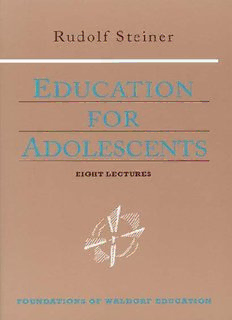
Education for Adolescents - Steiner - Featured Books PDF
Preview Education for Adolescents - Steiner - Featured Books
EDUCATION FOR ADOLESCENTS [X] FOUNDATIONS OF WALDORF EDUCATION R U D O L F S T E I N E R E DUCATION FOR A DOLESCENTS Eight lectures given to the teachers of the Stuttgart Waldorf School JUNE 12–19, 1921 Translated by Carl Hoffmann Anthroposophic Press The publisher wishes to acknowledge the inspiration and support of Connie and Robert Dulaney ❖ ❖ ❖ Introduction © Hans-Joachim Mattke, 1996 Text © Anthroposophic Press, 1996 This volume is a translation of Menschenerkenntnis und Unterrichtsgestaltung, which is vol. 302 of the complete works of Rudolf Steiner, published by Rudolf Steiner-Nachlassverwaltung, Dornach, Switzerland, 1986. Published by Anthroposophic Press 3390 Route 9, Hudson, NY 12534 Library of Congress Cataloging-in-Publication Data Steiner, Rudolf, 1861–1925. [Menschenerkenntnis und Unterrichtsgestaltung. English] Education for adolescents ; eight lectures given to the teachers of the Stuttgart Waldorf School, June 12–19, 1921 / Rudolf Steiner ; translated by Carl Hoffmann. p. cm. — (Foundations of Waldorf education ; 10) Includes bibliographical references and index. ISBN 0-88010-405-8 ISBN 0-88010-452-X (v. 2 : pbk.) 1. Education—philosophy. 2. Waldorf method of education, 3. Anthroposophy. I. Title. II. Series. LB775. S72E287 1996 370”.1—dc20 96-8224 CIP 10 9 8 7 6 5 4 3 2 1 All rights reserved. No part of this book may be reproduced in any form without the written permission of the publishers, except for brief quotations embodied in critical articles and reviews. Printed in the United States of America Contents Introduction by Hans-Joachim Mattke.................................. 9 LECTURE ONE Stuttgart, June 12, 1921 .................................................................15 Teaching should have a lasting effect on children. The nature of mem- ory. Feelings, humor, expectations as aids of memory. Listening, con- templating-doing, activities. The school as an organism. Harmony of physical and spiritual life. Hygienic effect of lessons LECTURE TWO Stuttgart, June 13, 1921 .................................................................... 31 Mental images, judgments, conclusions—their connection to head, legs, arms, hands, and feet; their connection to the etheric body, the astral body, and the ego. Head and limbs—their relation to cosmos and earth. Heredity. Connection of the physical/corporeal to soul and spirit. “Cos- mic” and “earthly” children. History lessons. Objectivity. Physical educa- tion. The teacher’s preparation. LECTURE THREE Stuttgart, June 14, 1921 ................................................................ 46 Adapting lessons to the children’s lives. Effects on the various constitu- ents during waking and sleeping. Eurythmy, music, physics, history. The complementary effects of subjects. Structuring lessons to adapt to the threefold being. Practical activities and the faculty of forming judg- ments. The practical aspects of geography. The time element in history. By ignoring the nature of sleep, we produce automata/robots. LECTURE FOUR Stuttgart, June 15, 1921 ................................................................ 59 The School as organism. Connection of the physical/corporeal to soul and spirit. Physical activities–mental activities. Writing, reading, listening to stories. In mental work, the physical organism is predominantly occupied. Salt deposits. The effects of interest, boredom. Eurythmy and singing lib- erate the spiritual in the limbs. Children with rich and poor imagination. Education interferes in human freedom. Memorizing. Handwork. LECTURE FIVE Stuttgart, June 16, 1921 ................................................................ 73 Radical changes occurring during the fourteenth and fifteenth years. Inner struggle for establishing a relation to the physical. Constitutional differences between girls and boys and their manifestations in behavior. Eroticism. The experience of beauty. The strengthening of the religious/ moral feelings. Different treatment for girls and boys during puberty. Shame; humor; ideals; role models. Education is to lead toward an understanding of life. Class 10 curriculum. LECTURE SIX Thursday, January 1, 1920 ............................................................ 87 Education during puberty demands the teachers’ deeper foundation and understanding of the world. Characteristic features of current educational systems. Interest in current world events a condition for educating children at this age. The youth movements. The Greeks’ relation to and understanding of the different ages. The natural sci- ences fail to provide a true picture of the human being and the world. The reason why we do not reach the young. The Greeks’ concepts of the four elements. LECTURE SEVEN Saturday, March 6, 1920 .............................................................. 64 Human connections between the different age groups. Ignoring the sub- tleties results in gaps among people. Examples of a knowledge of nature that comprehends life—in the spheres of plants, animals, human beings, and the cosmos. Spiritual-scientific penetration of feeling and sensation as bridge to an understanding of children during puberty. LECTURE EIGHT Stuttgart, June 19, 1921 .............................................................. 120 Inclination toward ideal at ages fourteen and fifteen. Self-chosen authority. Judgments. Protein. Our sciences and universities. Children’s imitation—the continuation of prenatal activities. Cultivation of the search for the truth. The ninth year. Development of the sense of Beauty. Love-duty. Change in the relation to authority. Concluding words. Bibliography ............................................................................... 137 Index .......................................................................................... 143 Introduction 9 Introduction The present lecture cycle, given in Stuttgart in June 1921 at the opening of the upper or high school and now titled Education for Adolescents, is also known as the Supplementary Course. This name suggests quite clearly that the talks were meant as an expansion and continuation of the cycle The Foundations of Human Experience, which Steiner had presented to the teachers at the opening of the Stuttgart Waldorf (elementary) school 1 two years earlier. Through these lecture cycles, Steiner advocated a consoli- dation of interest and interaction of all teachers in the curri- culum and teaching methods in the lower and middle elementary schools. Repeatedly in the Supplementary Course lectures, we read that the teachers of the high school should share with their colleagues in the lower grades and kindergar- ten a common interest in the children’s developmental stages in order to gain a meaningful and true picture of puberty and adolescence. A meaningful study of the Supplementary Course must, there- fore, be pursued against the background of the Foundations of 1. Previously titled Study of Man, this lecture cycle is now published as The Foundations of Human Experience by Anthroposophic Press, Hudson, NY, 1996.
Description: